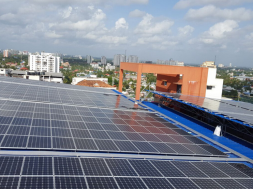
Beyond technology – Filling gap of Product Management in Solar & ESS manufacturing by Mr. Vivek Bhardwaj – EQ Mag Pro
Indian Manufacturers wants to own “manufacturing” and “partner with 3rd party mfrs. in advanced technologies”. While some sort of Product management must exist at Indian Manufacturers, a robust and powerful product management will drive your innovation.
As an analogy a manufacturing head will continue to make Maruti 800s unless Product Management steps in to innovate & make advanced products. With this context, the emphasis comes on the role of a “Program Manager “to work with various function across Module, Cell, energy storage, hydrogen, Back-sheet mfr, Glass / polycarbonate with the objective….
1. Drive “innovation projects “as they progress through GO / NO GO Decision Gate Systems.
2. Establish a common understanding of Product development system.
3. Develop & include templates for each step drawn from best practice
Step 1 Establish KPIs (long term with 1 year – 2-year horizon)
Product innovation KPIs are vectorial “technology “targets for a PRODUCT, in which Indian Manufacturers has decided to enter. “Technology” targets can be spearheaded either by “Technology team” (e.g. R&D Head) or “Product development”. The KPI activities need a “project sponsor” who can ideally be an anybody. Below are some examples of KPIs.
Wafer technology:
- 2022: Improved wafer sourcing quality by 0.25% increase in cell efficiency
- 2023: Realize 0.4% cell efficiency gain by technique 1&2 (e.g.)
Cell technology:
- 2022: 22,58% in line 3
- 2023: Demonstrate 0.5% cell efficiency increase by screen printing
- 2023: Develop technologies to facilitate >23% cell efficiency in 2023-2024 (n- type, plating, IBC-HIT)
Module technology:
- 2023: Commercialize Local Junction Box
- 2023: Demonstrate/realize 4-5W module gain by half cut cells and high transmission EVA
- 2023: 1.0-2.0 $ /module cost reduction by backsheet and EVA replacements
- qualification procedure
Product development:
- 2023: Evaluate generation gain contribution on products installed in 2022 (e.g. Special coating & special inverter)
- 2023: Integrate Potentially 3-5 new products
- 2023: Improve reliability understanding to give better predictions on warranties
Battery technology:
- 2022: Integrate with national DER
- 2023: Compatible with Sodium Ion battery with > 92% efficiency.
Electrolyze technology:
- 2022: Finalize 65kW electrolyzes
- 2023: Reduce boil off to 0,5% per hour for journey
RPDM Phases and Decision Gates
The Product development method needs to be highly structured and always followed the same path. However, some Strategic projects (like investment in Pervoskite/Electrolyzer Co) need not go through steps 3,4,5 as below

Such a process can create a positive culture and information sharing compared to companies which don’t follow the RPDM product management cycle. The main advantages in Solar context being….
• Ensure a consistent product and process development opportunities from idea through implementation. Each time same process will be used for decision making at Indian Manufacturers, it is less likely to go wrong. e.g. “Selection of HJT or Mono PERC Indian Manufacturers cell line?” “Choice of Bill of materials?” “Design of Indian Manufacturers Solar panel to maximize project development LCOE?” “Energy storage product with metal or plastic casing”)
• Ensure a fact-based and efficient decision making against business-critical success criteria. Standard templates like NPV, project charter and project teams to use it.
• Project predictability to deliver on quality, cost and timing. Weekly Charter review
• Alignment between organizational functions is optimized and all relevant parties are involved in an efficient manner. Inclusive decision making is the most important benefit to Indian Manufacturers compared to one person (usually the boss) solve problem.
• Ensure compatibility between Bidding team internal customer and management expectations and project deliveries reducing overhead to project to what is truly needed. Your bidding team like will be asked to sign off before any product under an RACI matrix.
• Ensure active use of the experience feedback loop.
Product Roadmap for the organization in manufacturing
The typical result of DG2 is a category of projects as a new or modified product, new material or equipment changes ready for full scale production. Equipment’s which make the cut will appear in the below product roadmap. They will be well defined and have gone through rigorous decision gate process. For them GO decision has been taken along with financial approval (how much to spend.). The products which appear in roadmap are “large or strategic investments “. e.g., Bi Facial panel can be part of Roadmap but what won’t appear in the roadmap is change in “Bill of Material’’
Pre-Defined Steps for the Decision Gate System
After the Review Committee recommends a project for a Decision Gate approval, the project team gets permission from the Review Committee to proceed to the next phase (DG)
Deliverables; Sign off Matrix
If your organization decides to implement the above proposal at Indian Manufacturers for Product Management, it will be challenging because it will become a “way of life for many people “so there will be resistance. The alternate in my experience is messier with potential for lots of arguments where the loudest voice wins & the product is SO -SO. It derives from collective wisdom of crowd.


















